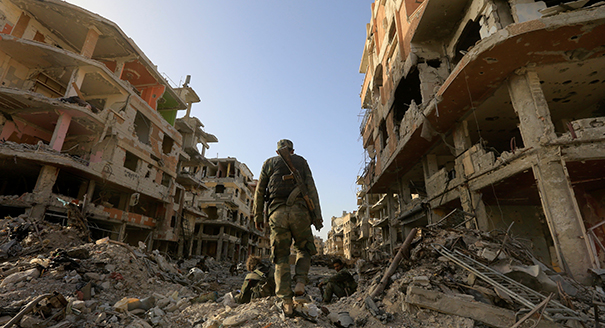With so much attention these days focused on the United States and its policies in the Middle East, it’s easy to forget that the region mainly functions according to dynamics that have little to do with the Americans or their whims.
A case in point is the recent decision of the United Arab Emirates and Bahrain to reopen their embassies in Damascus, thereby restoring ties with the Syrian government. Both countries are close allies of Saudi Arabia, so that one can safely assume that their decisions received Riyadh’s approval. They underline that the Saudis themselves intend to normalize relations with President Bashar al-Assad’s regime, regardless of the mass crimes it committed during the Syrian conflict. One account even suggested that Ali Mamlouk, the head of Syria’s National Security Bureau, had visited the kingdom some days ago.
Egypt reopened its embassy in the Syrian capital following the military coup against then-president Mohammed Morsi in 2013, and there have been reports since that time of Egyptian military collaboration with the Assad regime. Kuwait has also signaled that it may follow its Gulf partners in returning its diplomats to Syria. The recent visit to Damascus of Sudanese President Omar al-Bashir was yet another indication that Assad is finding his way back into the Arab fold, even as Bashir, who has been indicted by the International Criminal Court for war crimes, provided a suitable image of what the Syrian homecoming to the Arab mainstream will imply.
What we’re seeing was predictable, namely a rallying of the forces of the Arab counterrevolution around the principle of suffocating any remaining impulse for dissent in the region. What lies ahead is an even more repressive atmosphere in many Arab countries, in which none of the problems that led to the uprisings in 2011 have been resolved. Instead, the lesson embraced by Arab regimes is that they were not violent enough in smothering their societies, so that Assad’s resort to mass murder may emerge as a model for the future by leaders dead set on remaining in office at whatever the price.
In this context, what does the rivalry between certain Arab states and Iran signify? If anything, the Arab effort to move closer to the Syrian regime will replicate the behavior visible only a few years ago when Arab states used rewards to try drawing Syria away from Tehran. This would allow Bashar al-Assad to again win concessions—including Arab funding for Syria’s reconstruction and perhaps renewed influence over Lebanon—even as he does little to fulfill Arab wishes.
Assad’s ability to play the Arab states will quite possibly mean that Iran’s role in Syria will remain much as it was. There may be an Arab effort to strengthen Russia’s Syrian presence to counterbalance the Iranians, but the Russians are no more willing to be used by Arab regimes against Iran than is Assad. In other words the ability of Arab states themselves to contain Iran is as limited today as it was over eight years ago, before the Arab uprisings upended the whole region.
But what about non-Arab states? For a long time Iran’s Arab foes looked for salvation from the United States. A decade ago, then-king Abdullah of Saudi Arabia urged Washington to “cut off the head of the snake” by bombing Iran’s nuclear infrastructure. With the Trump administration willing only to impose sanctions on Iran, Arab hopes have shifted to another non-Arab actor, Israel. By attacking Iranian targets inside Syria, the Israelis have fulfilled some Arab desires, even as Israel’s backers in the U.S. are applauding President Donald Trump for giving the Israelis the leeway to pursue such activities.
So what we appear to have today is a regional order that rests on the self-reinforcing pillars of hardened Arab autocracy, adaptation to a post-American era in which Israel would play an expanded role in curbing Iran, and a reinvigorated Russia manipulating all sides in the pursuit of greater regional influence. The Americans are absent from this display, even if they have been essential to its emergence. But the main question is where all this will lead. Will it stabilize the Middle East, or on the contrary generate new and destructive dynamics?
It’s difficult to imagine that in a region already unable to address the everyday needs of its citizens the outcome will be anything but more ruin. Tyranny, coupled with widespread economic deterioration and the memory of the protests of 2011, will not bring tranquility. Reliance on Israel, which will serve primarily to protect the regimes in most Gulf countries from Iran, may well create serious legitimacy problems for these regimes since their survival will be tied to the sacrifice of the Palestinians. And Moscow’s enhanced position will be a disrupting factor, because the Russians, though they claim to be purveyors of immovability, will have a stake in exploiting divisions among their regional partners to enhance their own power.
How Iran will emerge from this is anybody’s guess. The Islamic Republic, no less vicious than its Arab neighbors, is dealing with a major economic crisis at a time when its leader is nearly 80 and on his way out and the system is provoking unprecedented popular frustration. The regime will face new existential challenges, but it’s also very possible that the foul conditions in the Arab world will create openings for Iran that can mitigate their impact.
This abundance of regional abnormality should discourage a reading of the region that reduces everything to the expansion of Iranian power. Iran’s rise is indeed a major destabilizing force in the Middle East, but it is also a symptom of the degradation of the Arab state system, in much the same way as was the rise of the Islamic State. The system’s actors are now circling their wagons to preserve authoritarian rule, but its mechanisms have decayed. Expect new upheavals, as an equilibrium of despots is often no equilibrium at all.






